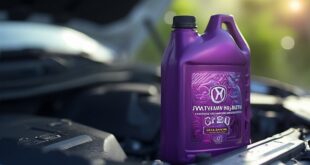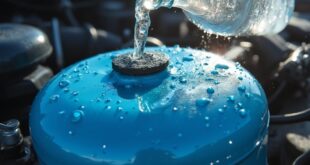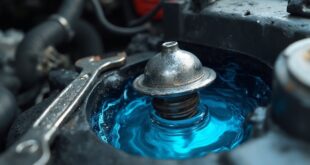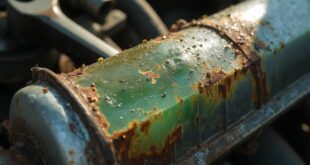If your car won't start after getting gas, it might be due to a clogged fuel filter, a defective fuel pump, or a malfunctioning EVAP purge control valve. Contaminated fuel can also lead to issues, while a dead battery or failing alternator could drain your power. Additionally, problems with the ignition system may prevent the engine from cranking. There are various factors at play, and you'll want to explore them to find the right solution.
Clogged Fuel Filter
When your car won't start after getting gas, one potential culprit could be a clogged fuel filter. This filter prevents contaminants from reaching your engine, but over time, it can become blocked.
You might notice reduced fuel efficiency or a lack of power when driving. If your filter hasn't been replaced in 20,000 to 30,000 miles, it's time to contemplate changing it.
Using top-tier fuel can help keep it clean, but regular maintenance is key to avoiding issues.
Don't ignore these signs; addressing a clogged filter promptly can save you from further complications down the road.
Defective Fuel Pump
If your car won't start after getting gas, a defective fuel pump might be to blame. This vital component delivers fuel from your tank to the engine. Symptoms of a failing fuel pump include engine sputtering and a whining noise. If the pump overheats due to low fuel levels, it can suffer severe damage. Diagnosing the issue often requires a pressure gauge, and replacement can be complex. Here's a quick overview:
| Symptoms | Causes | Solutions |
|---|---|---|
| Engine sputtering | Low fuel levels | Fill tank regularly |
| Whining noise | Pump overheating | Replace fuel pump |
| Difficulty starting | Clogged lines | Clean or replace lines |
| Stalling | Electrical issues | Inspect wiring |
| Poor acceleration | Fuel contamination | Use quality fuel |
Bad EVAP Purge Control Valve
A bad EVAP purge control valve can be a frustrating culprit behind your car's failure to start after refueling.
When this valve gets stuck open, it allows too much fuel vapor into the intake manifold, making it hard for your engine to start.
Here are some signs to watch for:
- You notice a strong fuel smell.
- Your engine cranks but won't fire up.
- The check engine light is on.
- You experience rough idling.
Addressing this issue promptly can save you from further complications and keep your car running smoothly.
Don't ignore these signs!
Bad Gas Impact
It's not just the EVAP purge control valve that can cause your car to struggle after getting gas; bad gas can also wreak havoc on your engine. Poor combustion from contaminated fuel leads to misfiring, making it difficult for your engine to start. You might notice sticky residue on engine components, which can further complicate matters. Testing for bad gas is essential, and cleaning any residue can help restore functionality.
| Symptoms | Solutions |
|---|---|
| Engine sputtering | Test fuel quality |
| Misfiring | Clean engine components |
| Reduced power | Replace fuel filter |
| Difficulty starting | Consult a mechanic |
Dead Battery
When your car won't start after getting gas, a dead battery might be the culprit. You might notice dim lights, sluggish accessories, or a complete lack of response when you turn the key.
Here are some quick checks to determine if your battery's dead:
- Look for corrosion on battery terminals.
- Listen for clicking sounds when you try to start.
- Check if your dashboard lights are dim or off.
- Try jump-starting your car, but move away from the fuel pump first.
If the battery's the issue, a replacement should get you back on the road.
Failing Alternator
If your car won't start after getting gas, a failing alternator could be the hidden issue draining your battery's power.
The alternator's job is to recharge the battery while the engine runs, and if it's malfunctioning, your battery may not receive the necessary charge. You might notice dimming lights or electrical accessories not working properly.
To check, use a multimeter; the voltage should rise when the engine's running. If it doesn't, you may need to replace the alternator to guarantee your battery stays charged and your car starts reliably.
Don't ignore these signs; they could lead to bigger problems.
Ignition System Health
Confirming your ignition system is in good health is essential for a reliable start, as faulty spark plugs or ignition components can prevent the engine from firing.
Here are four key areas to check:
- Spark Plugs: Inspect for wear or fouling; replace if necessary.
- Ignition Coils: Test for functionality; faulty coils can disrupt spark delivery.
- Wiring: Look for damaged or frayed wires that could affect connections.
- Battery Connections: Confirm terminals are clean and tight to maintain proper power flow.
Addressing these components can help you avoid frustrating no-start situations after refueling.
Frequently Asked Questions
Can Bad Gas Cause Permanent Engine Damage?
Yes, bad gas can cause permanent engine damage. If you suspect bad fuel, you should have it tested immediately. Cleaning your fuel system and replacing contaminated gas can help prevent long-term issues with your engine.
How Often Should I Replace My Fuel Filter?
You should replace your fuel filter every 20,000 to 30,000 miles to guarantee peak performance. Regular maintenance helps prevent clogging and keeps your engine running smoothly. Check your owner's manual for specific recommendations.
What Should I Do if My Car Won't Start at the Gas Station?
If your car won't start at the gas station, check the fuel gauge, listen for unusual sounds, and inspect for leaks. If issues persist, consider calling a mechanic for further assistance or diagnostic help.
Can Extreme Weather Affect My Car's Starting Ability?
Yes, extreme weather can affect your car's starting ability. Cold temperatures can thicken oil and weaken batteries, while heat can cause vapor lock. Proper maintenance and checks help guarantee your vehicle performs well in any weather.
Is It Safe to Jump-Start a Car Near a Gas Pump?
It isn't safe to jump-start a car near a gas pump. Sparks from the battery can ignite fuel vapors. Always move your vehicle away from the pump and perform jump-starts in a well-ventilated area.
 Car Service Land Coupons for Oil change, Tires, Wheel alignment, Brakes, Maintenance
Car Service Land Coupons for Oil change, Tires, Wheel alignment, Brakes, Maintenance




